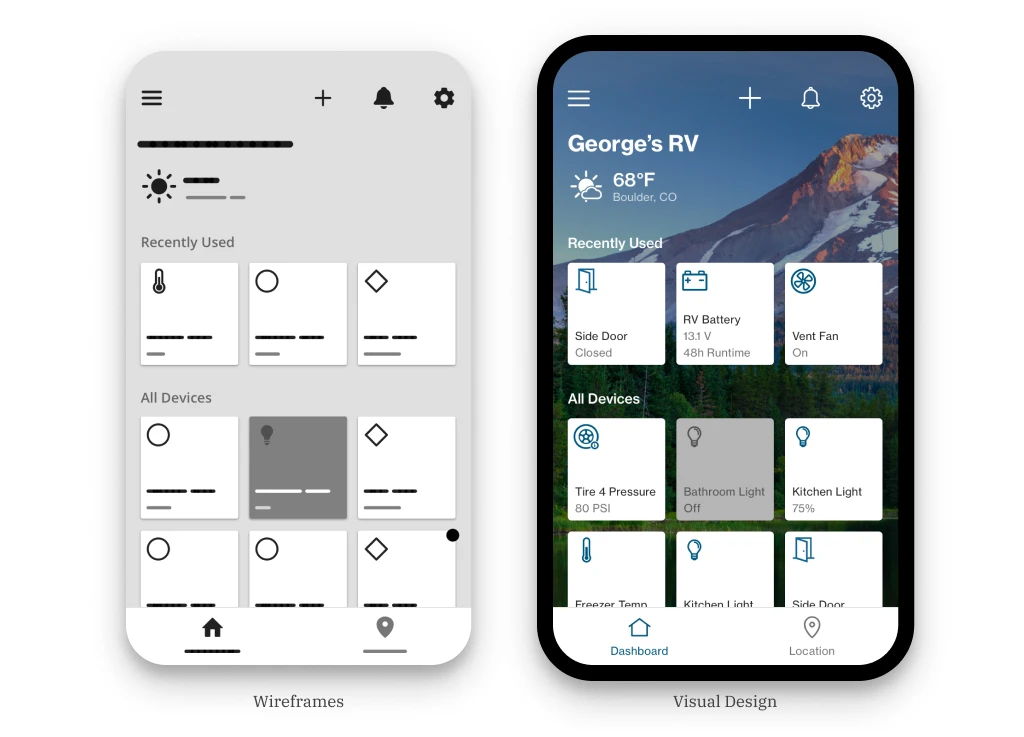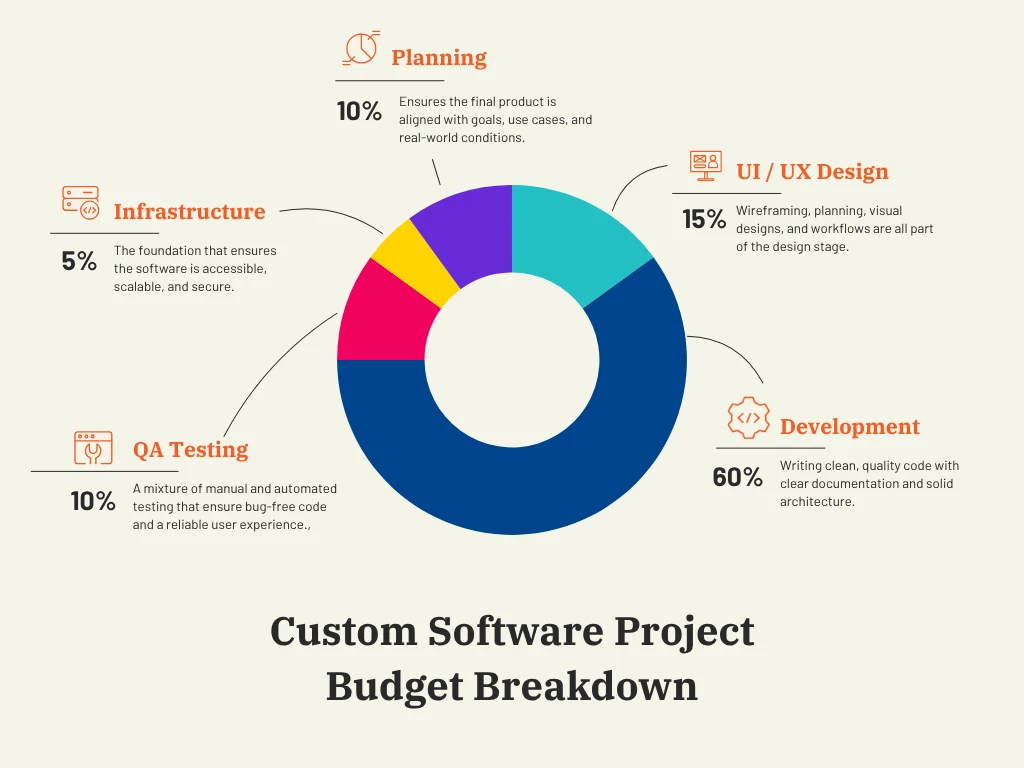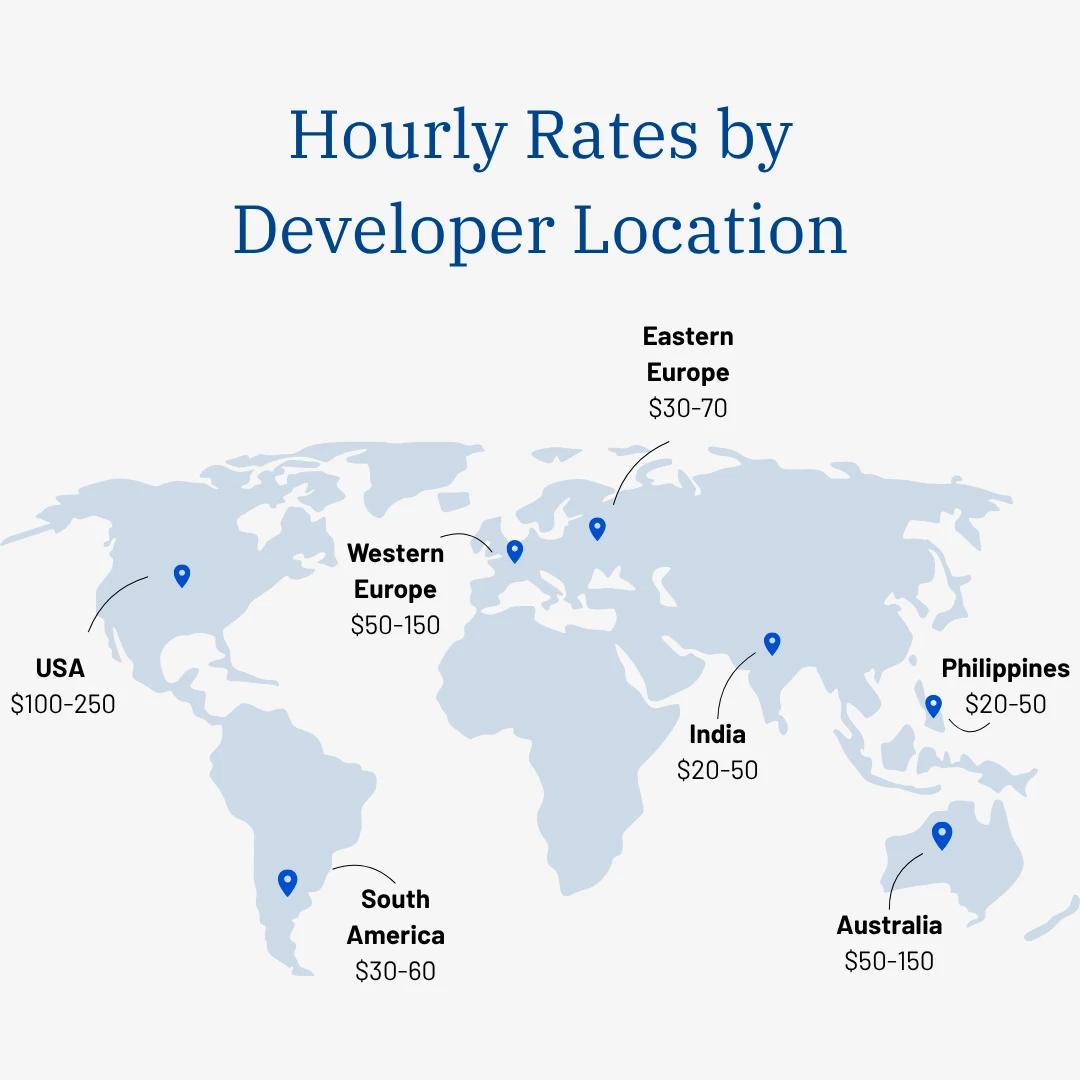Asking, “How much does custom software development cost?” is akin to asking, “How much does it cost to build a house?”
Are you envisioning a cozy cabin, a modern smart home, or a high-rise with built-in security and rooftop amenities? The cost varies dramatically depending on what you want.
Custom software works the same way. It’s a tailored solution built to fit your business needs, whether that’s a simple data entry form or a robust enterprise platform. Costs fluctuate depending on what you’re building, how you’re building it, and who’s doing the work.
Quick Answer: How Much Does Custom Software Development Cost?
Custom software development costs between $50,000 and $250,000 for most projects, but can exceed $1 million for complex enterprise systems. Pricing depends on project scope, design, integrations, and the team.
In this article, we’ll walk through the key factors that influence custom software development pricing so you can budget confidently, avoid sticker shock, and set realistic expectations.
Think of Custom Software Development Costs Like Building a House
Let’s keep the house analogy going. Imagine you’re meeting with contractors to build your dream home. Before they can give you a quote, they need to know:
- How big is the house?
- Is it one story or three?
- Do you want smart home tech, a pool, and/or solar panels?
- What kind of finishes and materials do you want?
- Are you building in a major city or a rural area?
- Do you want it done in six months or two years?
This is the same kind of information a software development team needs to estimate the custom software development cost for your project accurately.
What Impacts Custom Software Development Cost?
1.) Project Scope and Complexity
The size and complexity of your software project will have the most significant impact on the custom software development cost. Just like a house can be a tiny home or a sprawling estate, custom software development projects range from simple websites to complex enterprise systems. The more features, integrations, and use cases, the more it costs.
To see how complex your project may be, consider the following:
- Does your software require multiple user types?
- Does your software integrate with other systems?
- Does it need to be accessible from multiple devices?
- Does it need to function offline?
- Will it be used by multiple different teams for different functions?
- Do you need reporting & analytics?
- Is your application customer-facing?
If you answered yes to more than one of these questions, the chances are your project is more complex than meets the eye. Remember, simple to explain does not mean it’s simple to build.
Pro Tip: Clearly define your project scope from the start. The more detailed and specific you can be about your app’s functionality, the easier it will be for development teams to provide an accurate estimate. And, the easier it is to know if you are comparing apples to apples.
2.) Consulting & Product Planning: Hiring the Architect
Product planning is like the architectural design phase of any home project. It’s where you define your vision and validate whether your idea makes business sense before investing in development.
Consulting and product planning can include:
- User and market research
- Defining your MVP (minimum viable product)
- Creating a roadmap
- Mapping out features and user flows
- Identifying edge cases, compliance needs, and key KPIs
Skipping this step can lead to wasted development time, misaligned features, or a product that doesn’t solve the real problem. Just like you wouldn’t build a house without blueprints, you shouldn’t build custom software without a plan.
3.) UI/UX Design: Selecting the Finishes
When it comes to software design, you have options. Think of it like the finishes in a house: you can have a functional builders-grade bathroom or you can install marble tile, a rainfall shower, and heated floors. Both will work, but the experience (and budget) is very different.
- Minimal Design (basic countertops): Wireframes, a simple layout, and standard UI elements.
- Polished UI (quartz countertops): Custom styling, polished interfaces, intuitive navigation, and mobile responsiveness.
- Full Design System (luxury remodel): Comprehensive brand guidelines, reusable components, design tokens, and accessibility standards.

The more time and thought you put into design, especially during early UX strategy and user flow planning, the more intuitive and engaging your app will feel. But it does come at a cost.
If your app is customer-facing, skipping design is like building a luxury home and furnishing it with plastic lawn chairs. Technically, it’ll be functional, but not the impression you want to leave.
Design can account for 10–25% of a project’s total budget, depending on your goals.
4.) Software Development: Skilled Professionals Build Quality
Just like building a house isn’t just about nailing boards together, developing custom software is more than writing code that “works”.
Great software comes from a combination of:
- Best Practices (structural integrity): Writing clean, maintainable code with proper structure, naming, and version control.
- Documentation (blueprints): Clear documentation ensures future developers (or even your own team) can understand and maintain the system.
- Architecture (load-bearing walls): Choosing the right frameworks, databases, and design patterns ensures your software can grow and evolve.
- Security (fireproofing): Following security standards and data protection practices from the beginning protects you and your users.
Development quality can dramatically affect both the upfront cost and the long-term maintenance of your software. It may not always be visible, but it determines whether your product can stand the test of time.
Sure, you can build a house out of cheap materials, but it probably won’t last through a storm. Shortcuts might get your app live faster, but they often lead to technical debt (fragile code that breaks easily, can’t scale, and is expensive to fix).
Expect custom software development costs to take the majority of your budget, anywhere from 60-75% of the total project costs.
5.) Quality Assurance (QA): The Final Inspection
Would you move into a house that hasn’t been inspected? Probably not. And you shouldn’t launch software that hasn’t been tested either.
That’s where QA comes in. Think of it like your building inspectors. Their job is to ensure that everything works as expected, is up to code, and won’t break under pressure.
QA isn’t just about catching bugs – it’s about maintaining standards. QA testers and engineers check:
- Does the app function correctly on different devices and browsers?
- Are there security vulnerabilities?
- What happens if a user enters the wrong data or loses connection?
They simulate real-world conditions, just like a home inspector might test the outlets or run water through the pipes. Skipping QA to save money can end up costing you more if your users run into issues post-launch.
Expect QA to make up 10–20% of your overall development budget and potentially save you much more in support, reputation, and fixes down the line.
6.) Infrastructure & Hosting: The Foundation, Utilities, & Security System
Every house needs a foundation, plumbing, electricity, and security, even if it’s invisible. Software is no different. Infrastructure is what keeps your platform running, secure, and ready to grow.
Both infrastructure and DevOps affect cost based on:
- Scalability (auto-scaling, load balancing)
- Security (firewalls, encryption, access control)
- High availability (failover systems, backups)
- Ongoing monitoring and logging
- Regulatory compliance (HIPAA, SOC 2, GDPR, etc.)
Infrastructure might not be flashy, but it’s foundational. Cutting corners here can lead to outages, poor performance, or data breaches (the software equivalent of a flooded basement or a break-in). A 2023 study found that 48% of sensitive data loss came from compromised software systems (source).
Infrastructure costs depend on usage, storage, and architecture, but expect it to account for 5–15% of the initial build, plus monthly hosting and monitoring fees.

7.) Maintenance and Updates
Even after you move into your new home, you’ll need to maintain it, replacing filters, repainting, and fixing that one door that always sticks. Software’s no different.
Technology evolves. Security patches come out. Users give feedback. Over time, you may want to add features, fix bugs, or update for new devices and platforms. This is normal and should be budgeted for, just like homeowners set aside funds for repairs or renovations.
Typically, maintenance costs can range from 15% to 20% of the initial development cost per year. For example, if your app cost $100,000 to build, you might expect to pay $15,000 to $20,000 annually for updates and bug fixes. Of course, that doesn’t include new features or ongoing development.
8.) Development Team and Expertise
The quality and expertise of the team you hire will significantly influence the cost. Custom software development typically involves a team with diverse, specialized skillsets.
When building this team, you’ll need to decide whether to hire a freelancer, a small development agency, or a large, established software company, or various combinations in between. Each option has its advantages and drawbacks, which are explored deeper here.
Suffice to say, selecting the right team is critical to the success of your software. Continuing the house-building analogy… you probably wouldn’t hire a single handy-man to design and build your beach house.
9.) Location of the Development Team
Just like with housing, the location of your development team also affects pricing. A house in the middle of nowhere is significantly cheaper than one of prime beach-front real estate. Labor rates can range from $25/hr (offshore) to $250/hr+ (specialized U.S. firms).
- Offshore can be more affordable, but may come with time zone, language, or quality challenges.
- Onshore or nearshore teams often cost more but may offer smoother communication and higher quality.

Outsourcing is often a quick way to save costs in the short term, but be wary, cheaper doesn’t always mean better. A poorly built foundation will cost far more to fix later.
While lower rates aren’t always indicative of subpar work, the further away your team is, the less control and more risk you have. Be sure to consider the trade-offs in communication, time zone overlap, code quality, and support. Before you decide to go with the lowest cost option, ask yourself:
- Are you technical enough to verify product quality?
- Where would your main point of contact be located? Will this present communication issues?
- Is there a language barrier?
- What legal protections do you have if the project goes sideways?
- Is the cost saving worth the extra risk?
Like hiring local contractors, sometimes it’s worth paying more for reliability, trust, and smooth collaboration.
So… How Much Does Custom Software Development Cost Exactly?
While costs vary, here’s a rough idea based on scope:
- Basic MVP / Internal Tool: $50,000 – $100,000
- Mid-sized Web or Mobile App: $100,000 – $250,000
- Complex SaaS or Enterprise Software: $250,000 – $1,000,000+
Remember, these are high-level ranges. The real custom software development cost depends on your vision, complexity, and long-term goals.
Understanding the True Cost of Custom Software Development
Custom software development is an investment in your business’s future. Whether you’re building a mobile app, web solution, or enterprise platform, understanding the factors that drive development costs will help you make an informed decision.
So instead of asking, “What’s the cheapest quote I can get?”, ask:
- What am I trying to achieve?
- Who can help me plan and build it right?
- How do I make sure this investment pays off?
Whether you’re building a functional bungalow or a tech-powered dream home, choosing the right partner and planning the right foundation makes all the difference.
Recommended for You
Check out related insights from the team
Get empowered, subscribe today
Receive industry insights, tips, and advice from Saritasa.